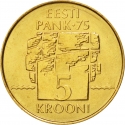You are about to finish your registration. Please check your mailbox (including spam folder). There should be a letter with a confirmation link. Check setting to make sure that your e-mail address is correct.
Send letter againDescription
In November 1917, following the collapse of the Russian Empire, the Estonian Provincial Assembly, known as the diet of the Autonomous Governorate of Estonia, declared itself the supreme authority in Estonia. This assembly, elected earlier in the year, assumed control amid the shifting political landscape.
Subsequently, in February 1918, the Salvation Committee of the Estonian National Council Maapäev convened in Tallinn and issued the Estonian Declaration of Independence. The committee also established the Estonian Provisional Government. However, this initial period of independence was abruptly cut short when German forces entered Tallinn the very next day.
The country fell under German occupation, and the Treaty of Brest-Litovsk was signed, relinquishing Russian claims to Estonia. German presence persisted until November 1918, when the conclusion of the war in the western front prompted their withdrawal to Germany. This departure created a void, allowing Bolshevik forces to enter Estonia, instigating the Estonian War of Independence, which endured for 14 months.
Obverse

|
Depicts three passant-gardant lions from the coat of arms of Estonia, within a shield dividing the issue year. 19 93 |
|---|---|
Reverse

|
Depicts a sculpture “Roe Deer” by J. Koort surrounded by the inscription "Republic of Estonia 75" and value. EESTI VABARIIK 75 |
| Edge |
Characteristics
| Type | Commemorative Issue (Circulating) |
| Material | Nordic Gold |
| Weight | 7.1 g |
| Diameter | 26.2 mm |
| Thickness | 2.06 mm |
| Shape |
|
| Alignment | Medal |
| Alt # |
|
| Mint |
RE Juveel, Tallinn, Estonia
|



